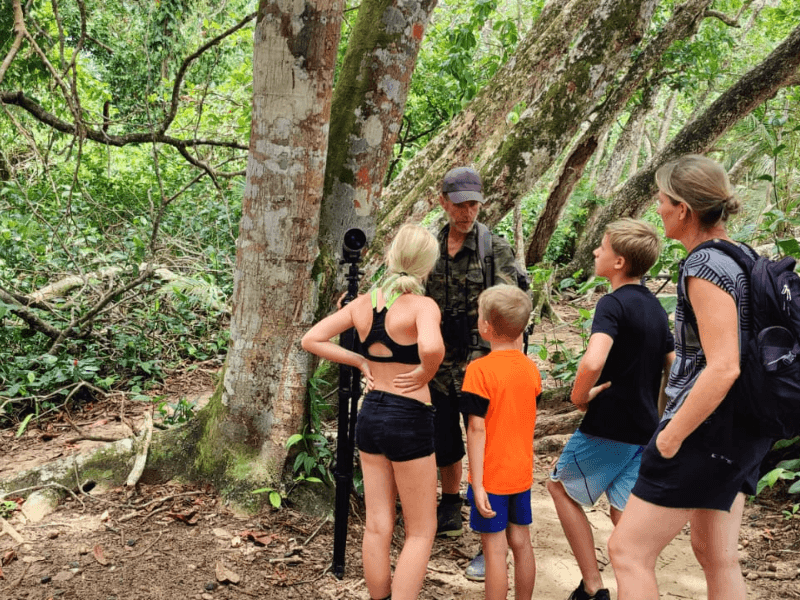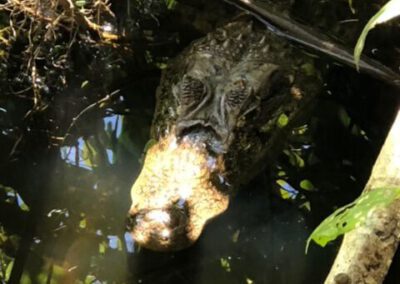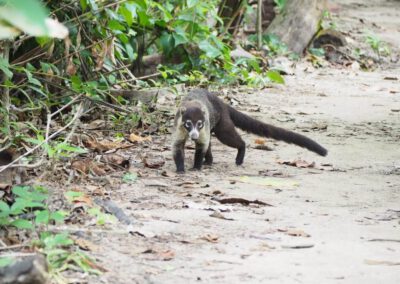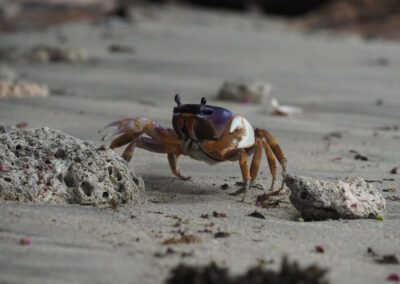Contents
Cahuita National Park Hike | Entrance Cahuita | Half-Day
Enjoy your trip and meet the Mammals during the Cahuita National Park Hike, lots of species, like howler monkeys, sloths, iguanas, spectacled caimans, toucans, snakes, and more.
And also essential and outstanding is the flora, fauna (beaches fringed by jungle vegetation).
Old giant trees, from the swamp forest to the most extensive coral reefs on the Caribbean coast of Costa Rica.
Cahuita National Park Hike | Half Day Tour – What to Expect?
The meeting point is around 9.00 in the morning at the entrance to the Cahuita National Park. During a 2.5-mile walk through the tropical coastal forest biotope, we can encounter a great diversity of animals and plants.
Think of all the mammals, birds, reptiles, amphibians, and insects that find refuge in this rich habitat.
For about 2,5, we look for all kinds of organisms that live here and learn about them.
As a former Biology teacher, I like to answer your questions about fauna and flora, so focus on what you want to know and would like to see.
For example, in my opinion, the Beach Almond tree is the most important tree species in the park because it feeds many animals, such as howler monkeys, hooded monkeys, and sloths. While it is leaving, litter feeds the soil animals. There are so many things connecting within the Ecosystem.
The jungle is also full of medicinal plants, such as the bark of the “Naked Indian tree” (Indio Denude) or the Noni tree. We will discover them together and maybe try one.
Upon request, we can combine tours with the visit to the Bribri waterfalls or the Turtle Rescue center of Cahuita or provide you with assistance, guidance, or suggestions; please ask us via this site or by the tour guides.
Duration
Approximately: 2,5 hours
What to bring with you
Sunscreen, drinking water, easy shoes, a towel, swim clothes if you want a fresh dip in the sea, and a rain cover. Making a valid weather forecast can sometimes be challenging. [It is not allowed to bring food in The Cahuita National Park].
Our Tour guides
Our guides are genuinely local and experienced tour professionals. They harbor a sincere and profound passion for nature and wildlife, deeply respect Costa Rican culture, are thoroughly prepared, and are licensed by the ICT (Costa Rican Tourism Institute).
Pricing
For pricing, see the shop product page and the “Additional Information” Tab; minimum group size [adults] = 2 persons. For youngster discounts, visit the product page!
What is Included
An accurate local experienced tour guide.
Meeting Point and Directions
The entrance to the National Park of Cahuita.
About Cahuita National Park Hike | Entrance Cahuita | Half-Day
The Cahuita National Park [parque nacional cahuita], is located in the Southern part of the Caribbean Coast of Costa Rica. It was founded in 1978. It is still the only national park in Costa Rica that depends exclusively on donations.
These are used to keep the park in the best possible conditions, free of pollution, and to ensure the safety of the wildlife and visitors.
Our tour guides offer a variety of adventurous, wildlife, hiking, and trekking tours.
The Coral Reef at The National Park of Cahuita is protected and can only be visited with the assistance of tour guides with a permit.
It is the largest fringing reef in the Caribbean in the country. This reef consists of three barriers, and it is a protected coral reef; the outer barrier stretches for 3 miles from the Western side of Punta Cahuita to the Eastern side; it is separated from the coast between 100 m and 2 miles.
It is a nesting ground for sea turtles, but that is not all you will see if you go scuba-diving or snorkeling.
The Reef is filled with over 240 marine life, including tropical fish species, sea urchins, sea cucumbers, manta rays, and even three species of sharks that call the coralline reef home.
There are at least 35 species of coral, over 120 species of fish, and many mollusks and crustaceans.
Wildlife
The National Park of Cahuita is home to countless species of wildlife. Among the more common mammals are armadillos, raccoons, sloths, howlers, and capuchin monkeys.
There are many species of reptiles and amphibians, including blue jeans dart frogs and red-eyed-leaf frogs, green iguanas, whip-tailed lizards, green vine snakes, and boa constrictors.
Perhaps the most notable reptile is the yellow eyelash pit viper, which has a brilliant golden-yellow color.
Many birds inhabit the park, including keel-billed and chestnut mandible toucans, fiery-billed aracaris, oropendolas, parakeets, parrots, herons, egrets, the ibis, the kingfisher, the Common black hawk, the woodpecker.
Protected Reef of the Cahuita National Park
Marine or ocean life is the plants, animals, and other organisms that live in the salt water of the sea or ocean or the brackish water of coastal estuaries.
At a fundamental level, marine life affects the nature of the planet. Marine organisms, mostly microorganisms, produce oxygen and sequester carbon.
Marine life, in part, shape and protect shorelines, and some marine organisms even help create new land (like coral-building reefs). Most life forms evolved initially in marine habitats. By volume, oceans provide about 90% of the living space on the planet.
The earliest vertebrates appeared as fish, which live exclusively in water. Some of these evolved into amphibians, which spend portions of their lives in water and portions on land.
One group of amphibians evolved into reptiles and mammals, and a few subsets of each returned to the ocean as sea snakes, sea turtles, seals, manatees, and whales.
Plant forms such as kelp and other algae grow in the water and are the basis for some underwater ecosystems. Plankton establishes the general foundation of the ocean food chain, particularly phytoplankton, which are key primary producers.
Marine invertebrates exhibit many modifications to survive in poorly oxygenated waters, including breathing tubes, as in mollusk siphons.
Fish have gills instead of lungs, although some fish species, such as lungfish, have both. Marine mammals (like dolphins, whales, otters, and seals) must surface periodically to breathe air.
Cahuita Reef has over 500 fish species, including three types of sharks, which you might encounter while snorkeling. However, a dozen other species include dolphins, blue parrot fish, rock beauty, the French angelfish, and even the dangerous Scorpio fish.
We also recommend a visit to the Turtle Cahuita Rescue Center. We can give directions. Often we combine this tour with the visit to the Turtle Center and the Bribiro Waterfall, which are both worthwhile to visit during your travel.
Cahuita National Park Hike | Entrance Cahuita | Half-Day
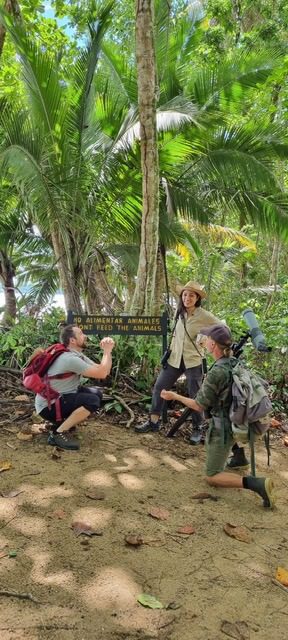

Take your camera – Make your Own Video Memory
Howler and Capuchin Monkeys – Cahuita National Park
Do you need to book in advance to visit Cahuita National Park?
It is recommended to book in advance to visit Cahuita National Park, especially during peak season, which is from December to April. This is because the park can get quite crowded during this time, and booking in advance will ensure that you are able to secure a spot and avoid any disappointments.
What's the best way to see Cahuita National Park?
Cahuita National Park is a beautiful and biodiverse park located on the Caribbean coast of Costa Rica. It’s known for its stunning beaches, vibrant coral reefs, and lush rainforests. To make the most of your visit to Cahuita National Park, here are some tips:
Guided Tours by Tour Guide Costa Rica | Our guides are trustworthy local experienced tour guides. They have an exceptional affection for nature and wildlife, respect for the Costa Rican Culture, are well-equipped, and love to show you the rich wildlife of the Cahuita National Park.
Consider taking a guided tour with a knowledgeable local guide. They can provide insights about the park’s flora and fauna, point out hidden gems, and ensure you get all the important features.
Hiking: Cahuita National Park offers well-maintained hiking trails that wind through the rainforest and coastline. The most popular course is the coastal path, which stretches about 8 kilometers (5 miles). It’s a relatively easy hike suitable for most fitness levels.
Snorkeling and Diving: The park is renowned for its coral reefs, so take the chance to snorkel or dive to explore the underwater world. The coral formations and colorful marine life are genuinely spectacular. You can rent snorkeling gear from local shops or bring your own.
Wildlife Watching: Watch for wildlife as you explore the park. You might spot howler monkeys, capuchin monkeys, sloths, iguanas, and various bird species. The park is home to diverse animals, so patience and keen observation will be rewarded.
Beach Time: Cahuita National Park boasts some stunning beaches. Playa Blanca and Playa Vargas are great spots for swimming, relaxing, and picnicking. Be cautious of solid currents and follow any safety guidelines provided.
Please respect the Environment: As with any natural area, practicing responsible tourism is crucial. Stay on marked trails, avoid disturbing wildlife, avoid picking plants or flowers, and don’t feed the animals.
Timing: The park is generally open from early morning to late afternoon. It’s a good idea to visit early in the day to avoid crowds and to have the best chance of spotting wildlife.
Weather and Gear: The Caribbean coast can be humid, so be prepared with appropriate clothing, including lightweight and breathable fabrics. Remember sunscreen, insect repellent, a hat, and comfortable footwear for walking.
Local Recommendations: When you arrive in Cahuita, ask locals for their recommendations on the best times to visit the park and any recent weather updates. They often have valuable insights to share.
Remember that Cahuita National Park is a protected area, so your visit can contribute to its conservation. By following these tips and being mindful of the environment, you can have an unforgettable experience while helping preserve the park for future generations.
